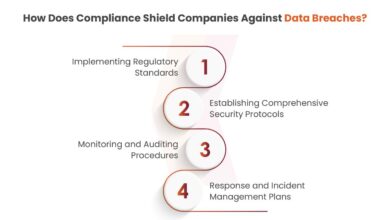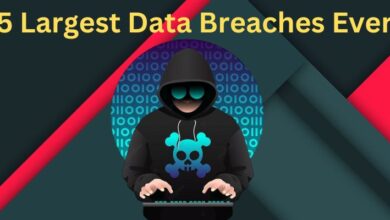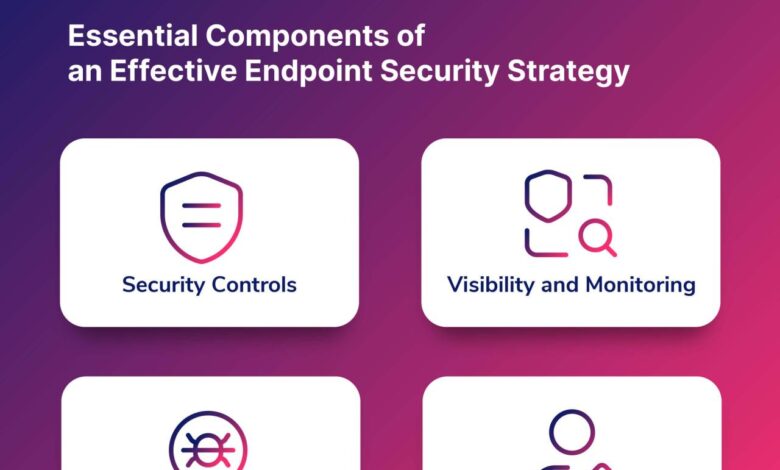
A Simple Guidance on Obtaining Effective Endpoint Security
A simple guidance on obtaining effective endpoint security is more crucial than ever in today’s hyper-connected world. We’re constantly bombarded with threats – malware, phishing scams, ransomware – all aiming to exploit vulnerabilities in our systems. This guide isn’t about overwhelming you with technical jargon; it’s about empowering you with practical steps to protect your devices and data. We’ll explore essential security measures, network configurations, user best practices, and strategies for preventing data loss.
Get ready to build a robust defense for your digital life!
From understanding the basics of endpoint security and identifying common threats to implementing robust security measures and responding to incidents, this guide provides a comprehensive yet accessible approach. We’ll cover everything from choosing the right security software to educating users on safe computing practices, ensuring you’re well-equipped to navigate the ever-evolving landscape of cybersecurity threats.
Introduction to Endpoint Security
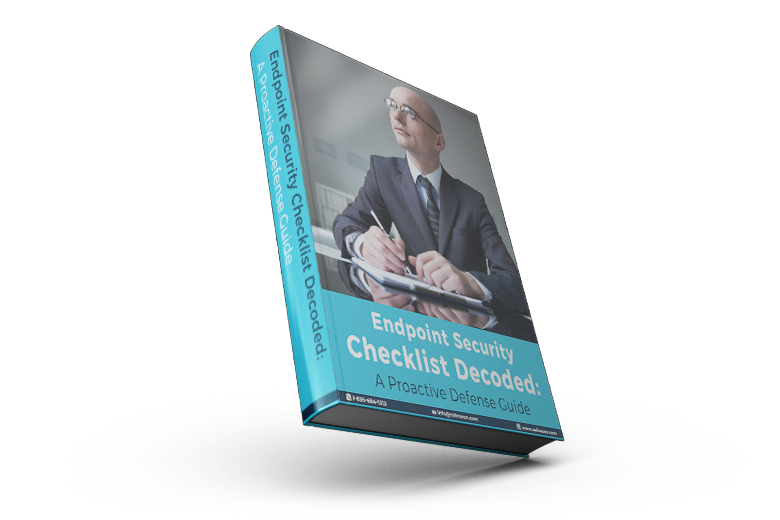
In today’s hyper-connected world, where businesses rely heavily on digital infrastructure and employees access sensitive data from various locations, endpoint security is no longer a luxury but a critical necessity. Endpoints – laptops, desktops, smartphones, tablets, and even IoT devices – represent potential entry points for cyberattacks, and securing them is paramount to protecting an organization’s valuable assets and reputation.
A robust endpoint security strategy is the cornerstone of a comprehensive cybersecurity posture.Endpoint security safeguards an organization’s digital assets by protecting individual computing devices from malicious software and unauthorized access. The increasing sophistication of cyber threats, coupled with the growing number of endpoints within organizations, underscores the need for a multifaceted approach to endpoint security. Neglecting this crucial aspect can lead to significant financial losses, data breaches, reputational damage, and legal ramifications.
Common Endpoint Threats
Endpoints are vulnerable to a wide range of threats. These include malware, such as viruses, ransomware, and spyware, which can infect devices and compromise data. Phishing attacks, often delivered via email or malicious websites, trick users into revealing sensitive credentials or downloading malware. Exploits target vulnerabilities in software to gain unauthorized access to systems. Insider threats, stemming from malicious or negligent employees, can also pose a significant risk.
Finally, denial-of-service (DoS) attacks can overwhelm endpoints, rendering them unusable. Understanding these threats is crucial for implementing effective security measures.
Endpoint Security Components
Effective endpoint security relies on a combination of technologies and practices. These key components work together to provide comprehensive protection. Antivirus and anti-malware software detect and remove malicious code. Endpoint Detection and Response (EDR) solutions monitor endpoint activity for suspicious behavior, providing advanced threat detection and incident response capabilities. Firewall protection prevents unauthorized network access.
Data loss prevention (DLP) tools monitor and prevent sensitive data from leaving the network without authorization. Regular software updates and patching address known vulnerabilities. Strong password policies and multi-factor authentication (MFA) protect against unauthorized access. Employee security awareness training educates users about common threats and best practices. Regular security assessments and penetration testing identify vulnerabilities and weaknesses in the security posture.
A comprehensive approach encompassing all these elements is necessary for robust endpoint security.
Essential Endpoint Security Measures
Protecting your endpoints—the devices accessing your network—is paramount in today’s threat landscape. A robust endpoint security strategy isn’t just about installing software; it’s about implementing a layered approach that minimizes vulnerabilities and maximizes protection. This involves a combination of technical controls, policies, and user education. Let’s delve into the key measures you should be implementing.
| Measure | Description | Implementation | Benefits |
|---|---|---|---|
| Anti-malware Software | Comprehensive software designed to detect, prevent, and remove malware, including viruses, ransomware, and spyware. | Install and maintain updated anti-malware software on all endpoints. Configure regular scans and automatic updates. | Reduced risk of malware infections, data breaches, and system compromise. |
| Firewall | A network security system that monitors and controls incoming and outgoing network traffic based on predetermined security rules. | Enable and configure firewalls on all endpoints, both hardware and software-based. Regularly review and update firewall rules. | Prevents unauthorized access to endpoints and protects against network-based attacks. |
| Regular Software Updates and Patching | Applying the latest security patches and updates to operating systems, applications, and firmware. | Implement a centralized patch management system or schedule regular updates on all endpoints. Prioritize critical security updates. | Reduces vulnerabilities exploited by attackers, minimizes the impact of known exploits, and improves overall system stability. |
| Data Loss Prevention (DLP) | Tools and techniques to identify, monitor, and protect sensitive data from unauthorized access, use, disclosure, disruption, modification, or destruction. | Implement DLP solutions that monitor data movement and enforce policies to prevent sensitive data from leaving the network without authorization. | Safeguards confidential information, minimizes the impact of data breaches, and ensures regulatory compliance. |
| Multi-Factor Authentication (MFA) | Requires users to provide multiple forms of authentication to verify their identity before accessing systems or data. | Enable MFA for all accounts accessing endpoints, including administrative accounts. Use a variety of authentication methods (passwords, tokens, biometrics). | Significantly strengthens account security and reduces the risk of unauthorized access, even if passwords are compromised. |
| Endpoint Detection and Response (EDR) | Advanced security technology that monitors endpoint activity for malicious behavior, provides threat detection, and enables incident response. | Deploy an EDR solution that continuously monitors endpoint activity, detects threats in real-time, and provides detailed investigation capabilities. | Enhanced threat detection and response capabilities, improved visibility into endpoint activity, and reduced dwell time of attackers. |
The Role of Anti-malware Software in Endpoint Protection
Anti-malware software forms the first line of defense against many endpoint threats. It acts as a crucial layer in a multi-layered security strategy. These solutions utilize various techniques, such as signature-based detection (identifying known malware), heuristic analysis (detecting suspicious behavior), and machine learning (identifying patterns indicative of malware), to identify and neutralize threats. Regular updates are critical to ensure the software remains effective against the constantly evolving threat landscape.
For example, the WannaCry ransomware attack in 2017 exploited a known vulnerability in older versions of Windows. Organizations that had applied the available patches were largely unaffected.
The Significance of Regular Software Updates and Patching
Software updates and patches address known vulnerabilities that attackers could exploit. These updates often include security fixes, bug fixes, and performance improvements. Delaying updates increases the risk of compromise. A well-defined patching strategy is crucial, prioritizing critical security updates and balancing the need for security with potential disruptions to operations. For instance, the Equifax data breach in 2017 was partially attributed to the company’s failure to patch a known vulnerability in Apache Struts, a widely used web application framework.
This highlights the severe consequences of neglecting timely patching.
Network Security for Endpoints
Securing your endpoints at the network level is crucial for comprehensive protection. A robust network security strategy complements your endpoint security software, creating a layered defense against threats. This involves careful configuration of firewalls and the strategic use of VPNs to protect data in transit and at rest.Effective network security hinges on a multi-layered approach, utilizing firewalls and VPNs to control network access and encrypt sensitive data.
This section will Artikel a simple, yet effective, network security configuration for endpoints, explaining the benefits of VPN usage and comparing different firewall types.
Endpoint Network Security Configuration
A basic, yet effective, network security configuration for endpoints involves a combination of a firewall and a VPN. The firewall acts as the first line of defense, controlling incoming and outgoing network traffic based on predefined rules. The VPN encrypts all traffic between the endpoint and a secure network, protecting sensitive data from eavesdropping and unauthorized access. This configuration is suitable for both personal and business use, offering a balance of security and usability.
For example, a home user might use a router with a built-in firewall and connect to a VPN service for secure online banking. A small business could implement a similar setup, using a dedicated firewall appliance and a VPN connection to a cloud-based server.
Benefits of Using a Virtual Private Network (VPN) for Endpoint Security
VPNs offer several key benefits for endpoint security. Primarily, they encrypt all data transmitted between the endpoint and the VPN server, preventing eavesdropping. This is particularly important when using public Wi-Fi networks or accessing sensitive data remotely. Additionally, VPNs can mask the endpoint’s IP address, enhancing anonymity and preventing tracking. This is useful for users who are concerned about their privacy or who are working in environments where their location needs to be masked.
For example, a journalist working in a sensitive location could use a VPN to mask their IP address and protect their identity. A business traveler accessing company data from a hotel Wi-Fi would benefit from the encryption and IP masking offered by a VPN.
Comparison of Firewall Types and Their Suitability for Various Endpoints, A simple guidance on obtaining effective endpoint security
Different firewall types offer varying levels of security and complexity. Software firewalls are built into operating systems or installed as applications. They are relatively easy to set up and manage but may offer less granular control than hardware firewalls. Hardware firewalls, on the other hand, are dedicated devices that handle network traffic independently. They offer greater performance and more advanced features, such as deep packet inspection.
Next-generation firewalls (NGFWs) combine traditional firewall functionality with advanced threat prevention capabilities, such as intrusion prevention systems (IPS) and application control.The suitability of each firewall type depends on the endpoint and its security needs. A basic software firewall might suffice for a personal laptop used primarily for browsing and email. A small business might benefit from a hardware firewall offering better performance and more robust security features.
Larger organizations with complex network infrastructures may require NGFWs to manage sophisticated threats. For example, a home user might utilize the built-in Windows firewall, whereas a bank might employ an NGFW with multiple layers of security.
User Education and Best Practices
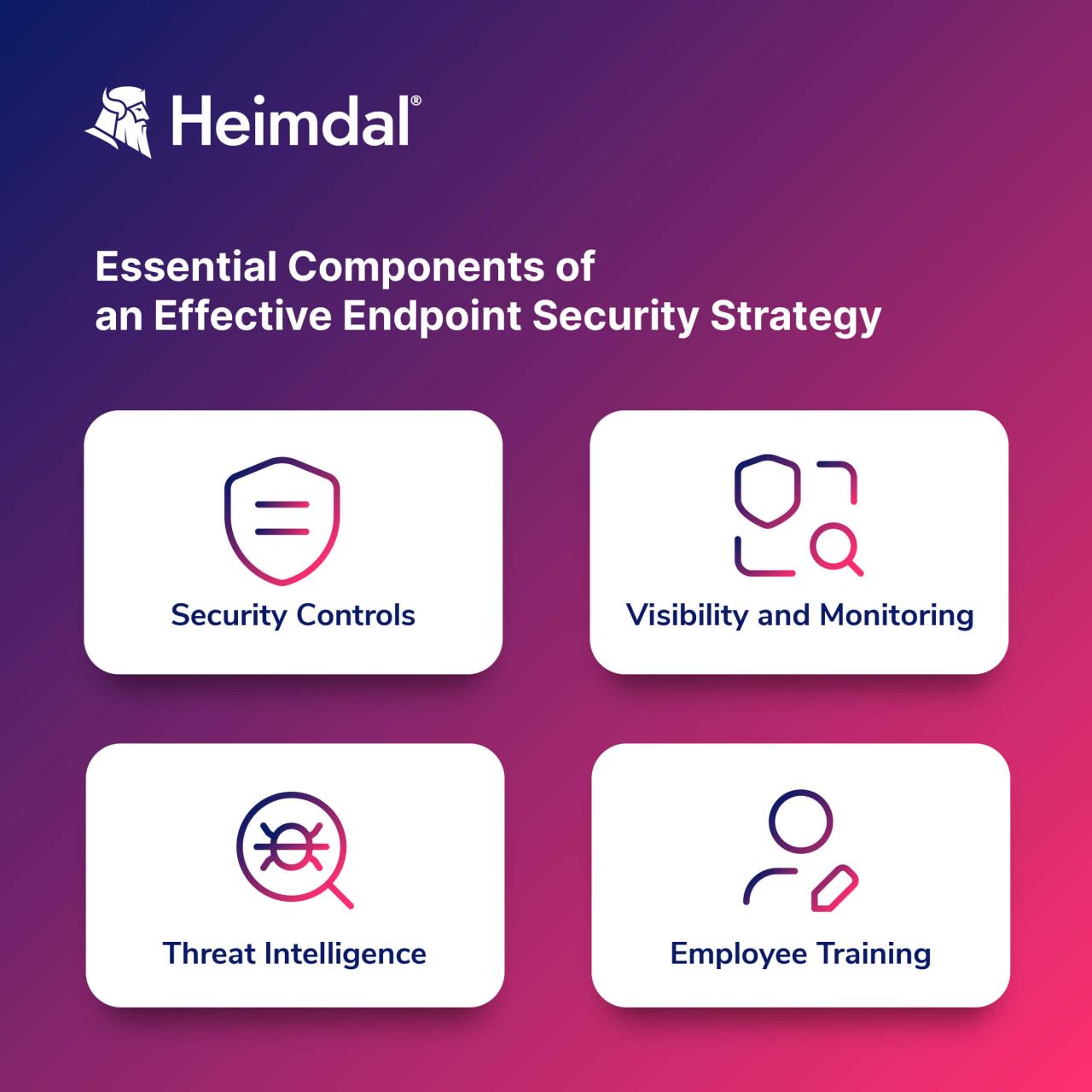
Effective endpoint security isn’t solely reliant on robust software and hardware; it hinges significantly on the actions and awareness of the users themselves. Human error remains a primary vulnerability, making user education a critical component of a comprehensive security strategy. By empowering users with knowledge and promoting safe computing habits, organizations can significantly reduce their attack surface and improve their overall security posture.
Implementing a comprehensive user education program is crucial for fostering a security-conscious culture. This involves a multi-faceted approach combining regular training, clear guidelines, and readily accessible resources. The goal is to transform users from potential security risks into active participants in maintaining a secure environment.
Best Practices for Enhanced Endpoint Security
Equipping users with practical, actionable best practices is paramount. These guidelines should be easily understood and consistently applied to maximize their impact. Regular reinforcement through reminders and updated materials is also essential to maintain effectiveness.
- Strong Password Management: Use strong, unique passwords for all accounts, avoiding easily guessable combinations. Consider using a password manager to generate and securely store complex passwords.
- Software Updates: Regularly update operating systems, applications, and antivirus software to patch known vulnerabilities. Enable automatic updates whenever possible.
- Phishing Awareness: Be cautious of suspicious emails, links, and attachments. Verify the sender’s identity before clicking on links or opening attachments. Report any suspicious communications immediately.
- Physical Security: Protect laptops and mobile devices from theft or unauthorized access. Use strong passwords and consider using device encryption.
- Data Backup and Recovery: Regularly back up important data to an external drive or cloud storage service. This safeguards against data loss due to hardware failure or malware attacks.
- Secure Wi-Fi Usage: Avoid using public Wi-Fi for sensitive tasks. When necessary, use a VPN to encrypt your connection.
- Endpoint Detection and Response (EDR) Awareness: Understand the role of EDR software in detecting and responding to threats. Familiarize yourself with its alerts and reporting features.
Training Module on Safe Computing Practices
A structured training module is essential for effectively educating users. This module should cover various aspects of safe computing practices, delivered through a combination of methods for optimal comprehension and retention.
The module should include interactive elements, such as quizzes and scenarios, to assess understanding and reinforce learning. Regular refresher training should be implemented to ensure users remain updated on the latest threats and best practices. This approach promotes continuous improvement in security awareness.
- Module 1: Introduction to Cybersecurity Threats: This section introduces common threats such as phishing, malware, and ransomware, explaining their mechanisms and potential impact.
- Module 2: Password Security and Authentication: This module covers best practices for password creation and management, including the importance of strong, unique passwords and the use of password managers.
- Module 3: Safe Browsing and Email Practices: This section educates users on identifying and avoiding phishing attempts, malicious websites, and unsafe email attachments.
- Module 4: Software Updates and Patching: This module emphasizes the importance of keeping software updated to protect against vulnerabilities.
- Module 5: Data Protection and Privacy: This section covers best practices for protecting sensitive data, including data encryption and secure data storage.
- Module 6: Mobile Device Security: This module focuses on securing mobile devices, including password protection, device encryption, and app permissions.
- Module 7: Reporting Security Incidents: This section instructs users on how to report suspicious activity or security incidents to the appropriate personnel.
Multi-Factor Authentication (MFA) Implementation
Multi-factor authentication (MFA) adds an extra layer of security by requiring users to provide multiple forms of verification before accessing systems or accounts. This significantly reduces the risk of unauthorized access, even if credentials are compromised. Implementing MFA across all critical systems and accounts should be a top priority for any organization.
MFA can be implemented using various methods, including time-based one-time passwords (TOTP), push notifications, security keys, or biometric authentication. The choice of method depends on the specific needs and security requirements of the organization. A well-designed MFA system should be user-friendly while providing robust security.
For example, a company might implement MFA for email access using a combination of a password and a one-time code sent to the user’s mobile phone via a TOTP app. This ensures that even if someone obtains the password, they still need access to the user’s phone to gain access to the email account. This significantly enhances security compared to password-only authentication.
Data Loss Prevention (DLP) Strategies
Data loss prevention (DLP) is crucial for endpoint security, safeguarding sensitive information from unauthorized access, use, disclosure, disruption, modification, or destruction. Effective DLP strategies go beyond simple antivirus; they involve proactive measures to identify and prevent data breaches before they happen. This requires a multi-layered approach combining technological solutions with robust policies and employee training.Implementing comprehensive DLP requires a layered approach.
This includes identifying sensitive data, implementing controls to prevent its exfiltration, monitoring for suspicious activity, and responding to incidents promptly. Effective DLP also integrates seamlessly with other security measures, creating a robust defense against data breaches.
Data Identification and Classification
Understanding what data needs protecting is the first step. This involves identifying sensitive data types like personally identifiable information (PII), financial data, intellectual property, and confidential customer information. Data classification involves assigning sensitivity levels to different data sets, enabling tailored protection measures. For example, highly sensitive data might require stricter access controls and encryption than less sensitive data.
So, you’re looking for a simple guidance on obtaining effective endpoint security? It’s all about layered protection, and a key part of that is securing your applications. For instance, consider how you’re developing your apps; check out this great article on domino app dev the low code and pro code future for insights into modern development practices.
Understanding your app security is crucial for overall endpoint security, remember to patch regularly and keep your software updated.
This classification process should be regularly reviewed and updated to reflect changes in business needs and regulatory requirements.
Endpoint DLP Tools and Their Functionalities
Several DLP tools offer various functionalities to prevent data loss. These tools typically employ several methods to detect and prevent data exfiltration. Some examples include:
- Data Loss Prevention (DLP) Suites: These comprehensive solutions often combine several DLP techniques, such as data discovery, classification, monitoring, and prevention. They can scan files, emails, and applications for sensitive data, blocking or alerting on suspicious activity.
- Network-Based DLP: These solutions monitor network traffic for sensitive data being transmitted outside the organization’s network. They can block or alert on unauthorized data transfers.
- Endpoint DLP Agents: These agents are installed on individual endpoints (computers, laptops, mobile devices) to monitor file access, copy/paste operations, and other activities that could lead to data loss. They can prevent sensitive data from being copied to unauthorized locations or devices.
Specific examples of DLP tools include McAfee Data Loss Prevention, Symantec DLP, and Forcepoint Data Loss Prevention. Each offers slightly different features and capabilities, but all aim to prevent sensitive data from leaving the organization’s control. These tools often integrate with other security solutions, providing a holistic approach to data protection.
The Role of Endpoint Detection and Response (EDR) in DLP
Endpoint Detection and Response (EDR) solutions play a significant role in bolstering DLP efforts. EDR systems continuously monitor endpoint activity, detecting malicious behavior and providing detailed insights into potential data breaches. By correlating events and identifying patterns indicative of data exfiltration attempts, EDR enhances the effectiveness of DLP tools. For example, if an EDR system detects unusual file transfers or access to sensitive data outside normal working hours, it can alert security personnel, enabling a prompt response to prevent data loss.
This proactive approach significantly improves the overall security posture.
Data Loss Prevention Policies and Procedures
Effective DLP requires more than just technology; robust policies and procedures are essential. These policies should Artikel acceptable use of company data, data classification guidelines, and procedures for handling sensitive information. Regular training for employees on these policies is crucial to ensure everyone understands their responsibilities in protecting company data. The policies should clearly define the consequences of violating data security policies, including disciplinary actions.
Monitoring and Incident Response
Effective endpoint security isn’t just about prevention; it’s about proactive monitoring and swift response to inevitable incidents. A robust monitoring and incident response plan is crucial for minimizing damage and maintaining business continuity. This involves continuous observation of endpoint activity, prompt detection of threats, and a well-defined process for containment, eradication, and recovery.A multi-layered approach to endpoint monitoring is essential.
This involves combining various security tools and techniques to gain a comprehensive view of endpoint activity. This includes utilizing Security Information and Event Management (SIEM) systems to aggregate logs from various sources, Endpoint Detection and Response (EDR) solutions for advanced threat hunting, and regular vulnerability scanning to identify and remediate weaknesses before they can be exploited. By correlating data from these different sources, security teams can identify patterns and anomalies that may indicate malicious activity.
For example, a sudden surge in outbound network connections to a known malicious IP address, coupled with unusual file activity on a specific endpoint, could signal a compromise.
Endpoint Security Event Monitoring Process
Effective monitoring requires a structured process. First, establish baselines of normal endpoint behavior by analyzing logs and network traffic over a period of time. This allows you to identify deviations from the norm, which might signal an attack. Next, implement real-time monitoring using SIEM and EDR tools, configuring alerts for critical events like failed login attempts, unusual process executions, and data exfiltration attempts.
These alerts should be prioritized based on severity and potential impact, allowing security teams to focus on the most critical threats first. Finally, regular review of security logs is vital, even in the absence of alerts, to identify subtle indicators of compromise that might have gone unnoticed. This proactive approach significantly increases the chances of early threat detection.
Incident Response Plan for Endpoint Security Breaches
A well-defined incident response plan is paramount. This plan should Artikel clear roles and responsibilities, escalation procedures, and communication protocols. The plan should follow a structured methodology, such as the NIST Cybersecurity Framework, which emphasizes preparation, identification, containment, eradication, recovery, and post-incident activity. For example, the identification phase might involve analyzing security logs and network traffic to pinpoint the source and scope of the breach.
Containment could involve isolating the affected endpoint from the network to prevent further damage. Eradication would involve removing the malware and restoring the system to a clean state. Recovery involves restoring data and applications, while post-incident activity focuses on lessons learned and improvements to the security posture.
Documenting and Reporting Security Incidents
Meticulous documentation is critical for effective incident response and future prevention. This includes maintaining a detailed log of all actions taken during the incident response process, along with timestamps and supporting evidence. This documentation should be readily accessible to all relevant personnel. A standardized incident report should be generated after the incident is resolved. This report should include a summary of the incident, the steps taken to contain and eradicate the threat, the impact of the incident, and recommendations for preventing similar incidents in the future.
This information is invaluable for continuous improvement of the organization’s security posture and can be used to inform future training and awareness programs. A common format for such reports, potentially including a section for root cause analysis, would ensure consistency and facilitate sharing of information across the organization.
Mobile Endpoint Security
Mobile devices, such as smartphones and tablets, have become indispensable tools in both personal and professional settings. This increased reliance, however, introduces significant security challenges that differ from traditional desktop environments. Their portability, constant connectivity, and diverse application ecosystems create vulnerabilities that require specific security measures.The inherent nature of mobile devices presents a unique set of security risks.
Unlike desktops, which are generally confined to a single location and network, mobile devices are frequently used in various locations, connecting to different Wi-Fi networks and potentially unsecured public networks. This exposes them to a wider range of threats, including phishing attacks, malware infections, and data breaches. Furthermore, the ease of losing or having a mobile device stolen increases the risk of sensitive data falling into the wrong hands.
The app stores, while offering a vast array of useful applications, also present a significant attack vector, as malicious apps can bypass security measures and steal data or compromise the device.
Mobile Endpoint Security Measures
Implementing robust security measures is crucial to mitigate the risks associated with mobile endpoints. A layered approach, combining various strategies, offers the most effective protection.
- Strong Passwords and Biometrics: Enforce strong, unique passwords and enable biometric authentication (fingerprint, facial recognition) to prevent unauthorized access.
- Regular Software Updates: Keeping the operating system and apps updated is vital to patch known vulnerabilities and improve security. Automatic updates should be enabled whenever possible.
- Mobile Threat Defense (MTD): Deploy MTD solutions to detect and prevent malware infections, phishing attempts, and other mobile threats. These solutions often incorporate real-time threat intelligence and behavioral analysis.
- VPN Usage: Encourage the use of Virtual Private Networks (VPNs) to encrypt data transmitted over public Wi-Fi networks, protecting sensitive information from eavesdropping.
- Data Encryption: Encrypt sensitive data stored on the device, both at rest and in transit, using strong encryption algorithms. Full-disk encryption is a particularly effective approach.
- App Permissions Management: Carefully review and manage app permissions. Only grant necessary permissions to apps to minimize the potential impact of a compromised application.
- Device Tracking and Remote Wipe: Implement device tracking capabilities to locate a lost or stolen device and enable remote wipe functionality to erase sensitive data in case of compromise.
Mobile Device Management (MDM) Solutions
Mobile Device Management (MDM) solutions provide a centralized platform for managing and securing mobile devices within an organization. They offer a range of features, including remote device wiping, application management, security policy enforcement, and device tracking. MDM solutions allow IT administrators to control access to corporate resources, ensure compliance with security policies, and monitor device activity.MDM solutions offer significant benefits for organizations, including improved security posture, enhanced control over corporate data, and simplified device management.
The choice of MDM solution depends on factors such as the size of the organization, the types of mobile devices used, and the specific security requirements. Some MDM solutions integrate with other security tools, such as endpoint detection and response (EDR) systems, to provide a comprehensive security approach. Effective implementation of an MDM solution requires careful planning, user training, and ongoing monitoring.
Consideration must be given to employee privacy concerns and compliance with relevant data protection regulations.
Security Audits and Assessments
Regular security audits and assessments are crucial for maintaining a robust endpoint security posture. They provide a snapshot of your current security status, identifying vulnerabilities and weaknesses before they can be exploited by malicious actors. This proactive approach allows for timely remediation, minimizing the risk of data breaches and costly downtime. Without regular audits, organizations risk operating with blind spots in their security defenses, leaving them vulnerable to attack.Endpoint security audits involve a systematic examination of all aspects of your endpoint security infrastructure.
This includes hardware, software, configurations, and user practices. The goal is to identify any deviations from best practices, misconfigurations, or vulnerabilities that could compromise the security of your endpoints. This process helps organizations comply with industry regulations and maintain a high level of security.
Endpoint Security Audit Steps
A thorough endpoint security audit typically involves several key steps. First, a comprehensive inventory of all endpoints within the organization is created. This includes desktops, laptops, servers, mobile devices, and any other connected devices. Next, a vulnerability assessment is performed to identify weaknesses in the system. This might involve using automated scanning tools to check for known vulnerabilities in software and operating systems.
Following this, configuration reviews are conducted to ensure that security settings are correctly implemented and enforced across all endpoints. Finally, a review of user access controls and security policies is performed to determine if appropriate measures are in place to prevent unauthorized access and data breaches. The entire process culminates in a detailed report outlining identified vulnerabilities, recommendations for remediation, and a prioritized action plan.
Checklist for a Basic Endpoint Security Assessment
A basic endpoint security assessment should include the following checks:
- Operating System Patching: Verify that all endpoints are running the latest operating system patches and updates.
- Antivirus Software: Confirm that up-to-date antivirus software is installed and active on all endpoints, and that regular scans are being performed.
- Firewall Configuration: Check that firewalls are properly configured to block unauthorized network traffic.
- User Access Control: Verify that user accounts have appropriate access privileges and that strong passwords are enforced.
- Data Encryption: Assess whether sensitive data is encrypted both in transit and at rest.
- Software Inventory: Create a complete inventory of all software installed on each endpoint to identify outdated or unpatched applications.
- Security Logs Review: Examine security logs for any suspicious activity or potential security incidents.
Regularly performing these checks will help organizations maintain a strong security posture and minimize their risk of security incidents. The frequency of these assessments should be determined based on the organization’s risk tolerance and regulatory requirements. For example, a financial institution might conduct audits monthly, while a smaller business might perform them quarterly.
Choosing the Right Security Tools: A Simple Guidance On Obtaining Effective Endpoint Security
Selecting the appropriate endpoint security tools is crucial for maintaining a robust security posture. The sheer number of available solutions, each with varying features and price points, can be overwhelming. Understanding your specific needs and environment is paramount before making a decision. This section will guide you through the process of evaluating and selecting the right tools for your organization.Endpoint security software comes in a variety of forms, each designed to address specific threats and vulnerabilities.
A comprehensive strategy often involves layering multiple solutions to achieve maximum protection. Careful consideration of features, pricing, and compatibility is essential to ensure a successful implementation.
Endpoint Security Software Categories
Endpoint security software can be broadly categorized into several key areas. These categories often overlap, and many solutions offer a combination of features. Understanding these categories helps in narrowing down the options based on your specific requirements. For example, a small business might prioritize a simpler, integrated solution, while a large enterprise might require a more modular approach with specialized tools for different aspects of security.
- Antivirus and Antimalware: These are foundational tools that detect and remove malicious software, such as viruses, worms, and Trojans. They often include real-time scanning, signature-based detection, and behavioral analysis.
- Endpoint Detection and Response (EDR): EDR solutions go beyond basic antivirus by providing advanced threat detection, investigation, and response capabilities. They often utilize machine learning to identify sophisticated attacks and provide detailed insights into malicious activity.
- Data Loss Prevention (DLP): DLP tools monitor and prevent sensitive data from leaving the organization’s control. They can monitor data in transit and at rest, preventing unauthorized access and data breaches.
- Vulnerability Management: These tools scan endpoints for vulnerabilities and provide recommendations for remediation. They are crucial for identifying and patching security weaknesses before they can be exploited.
- Security Information and Event Management (SIEM): While not strictly endpoint-focused, SIEM solutions play a vital role in aggregating and analyzing security logs from various sources, including endpoints, to provide a comprehensive view of the security posture.
Comparing Endpoint Security Software Solutions
Different vendors offer various endpoint security solutions with varying features and pricing models. Factors such as the number of endpoints, required features, and budget will significantly influence the choice. Some vendors offer subscription-based models, while others offer perpetual licenses. It’s crucial to compare the total cost of ownership (TCO), considering factors like implementation, training, and ongoing maintenance.
| Vendor | Features | Pricing Model | Target Audience |
|---|---|---|---|
| Vendor A | Antivirus, EDR, DLP | Subscription | Small to medium businesses |
| Vendor B | EDR, Vulnerability Management, SIEM integration | Subscription, per-endpoint | Large enterprises |
| Vendor C | Antivirus, basic endpoint protection | Perpetual license | Budget-conscious organizations |
Note: This is a simplified example, and actual vendor offerings and pricing may vary significantly.
Factors to Consider When Selecting Endpoint Security Tools
The selection process should consider various factors beyond just features and pricing. The specific needs of the organization, the complexity of its IT infrastructure, and the level of technical expertise available all play a crucial role. For instance, a healthcare provider with strict regulatory compliance requirements will have different needs than a small retail business.
- Scalability: The chosen solution should be able to scale to accommodate future growth and changes in the IT infrastructure.
- Integration: Seamless integration with existing security tools and systems is essential to avoid creating silos and improve overall efficiency.
- Ease of Management: The solution should be easy to manage and administer, minimizing the need for extensive technical expertise.
- Reporting and Analytics: Comprehensive reporting and analytics capabilities are essential for monitoring the effectiveness of the security measures and identifying potential threats.
- Compliance Requirements: The solution should meet all relevant industry regulations and compliance standards.
Last Point
Securing your endpoints isn’t a one-time task; it’s an ongoing process that requires vigilance and adaptation. By implementing the strategies Artikeld in this guide – from installing robust anti-malware software and regularly updating your systems to educating users and establishing strong incident response plans – you can significantly reduce your risk of cyberattacks. Remember, a proactive approach to endpoint security is the best defense against the ever-present threat of data breaches and system compromises.
Stay informed, stay vigilant, and stay protected!
FAQ Summary
What is the difference between antivirus and anti-malware software?
Antivirus software primarily focuses on detecting and removing viruses, while anti-malware software has a broader scope, protecting against a wider range of threats including malware, spyware, ransomware, and more.
How often should I update my software?
Software updates should be installed as soon as they are released. These updates often contain critical security patches that protect against known vulnerabilities.
What should I do if I suspect a security breach?
Immediately disconnect from the network, isolate the affected device, and follow your incident response plan. Contact your IT department or a cybersecurity professional for assistance.
Is a VPN essential for endpoint security?
While not strictly essential for everyone, a VPN adds a significant layer of security, especially when using public Wi-Fi or accessing sensitive data remotely, by encrypting your internet traffic.



